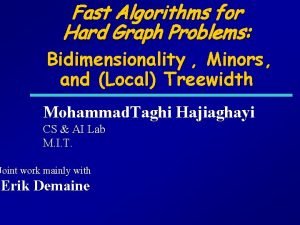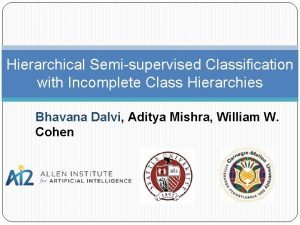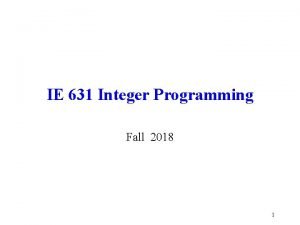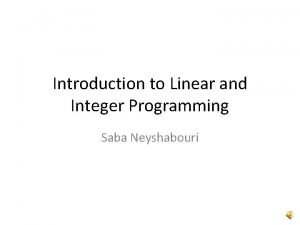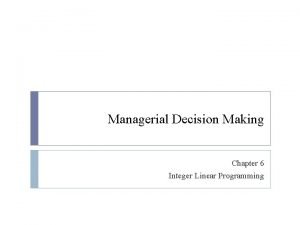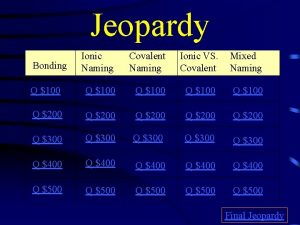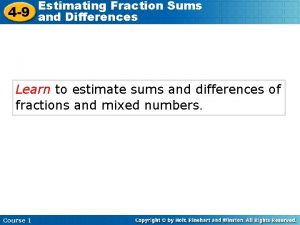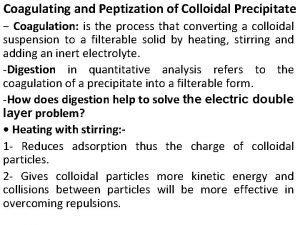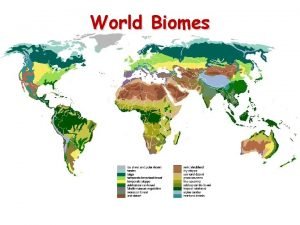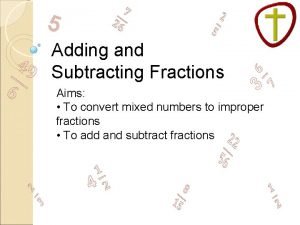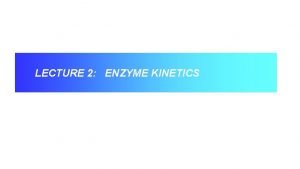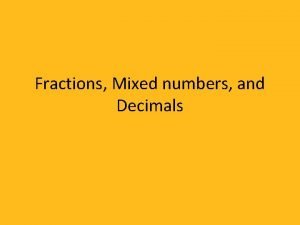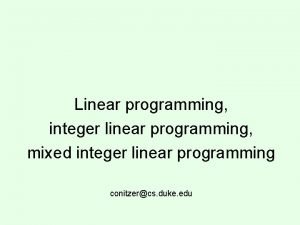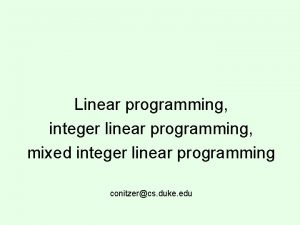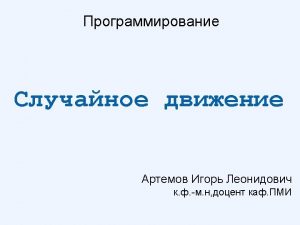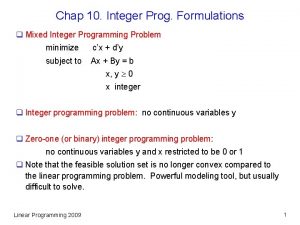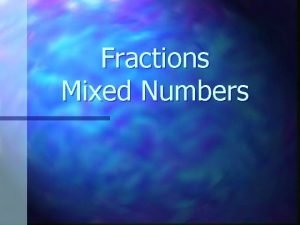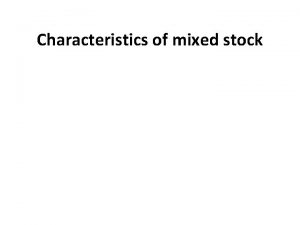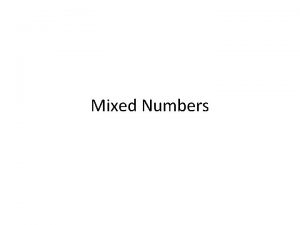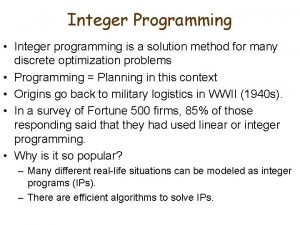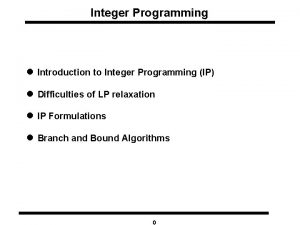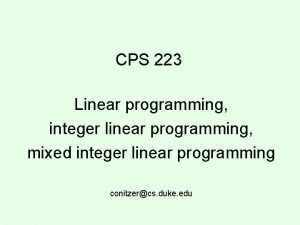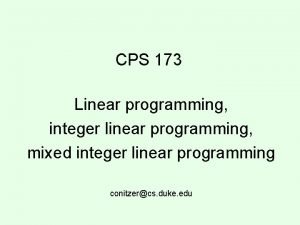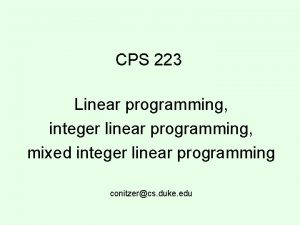Treewidth and Integer Programming Mixed Integer Programming workshop







![8 Definition Branchwidth, Treewidth, Pathwidth Robertson and Seymour [106]: For a graph G =(V, 8 Definition Branchwidth, Treewidth, Pathwidth Robertson and Seymour [106]: For a graph G =(V,](https://slidetodoc.com/presentation_image_h/78d84faaacc58fa32f0e44da095d3b55/image-8.jpg)

























- Slides: 33

Treewidth and Integer Programming Mixed Integer Programming workshop June 5, 2006, Miami Arie. Koster Zuse Konrad-Zuse-Zentrum Institute Berlin (ZIB) für Informationstechnik Berlin (ZIB) Zuse Institute (ZIB) Joint work with Adrian Zymolka (ZIB) koster@zib. de http: //www. zib. de/koster/ http: //www. zib. de/koster

2 Contents § Treewidth vs. Integer Programming § Treewidth by Integer Programming § Experiments Arie Koster

3 Definition Tree Decomposition § A tree decomposition: § Tree with a vertex set b associated with every node d a g c f e h § For all edges {v, w}: there is a set containing both v and w § For every v: the nodes that contain v form a connected subtree Arie Koster ac b af c c ed ag f gh

4 Definition Tree Decomposition § A tree decomposition: § Tree with a vertex set b associated with every node d a g c f e h § For all edges {v, w}: there is a set containing both v and w § For every v: the nodes that contain v form a connected subtree Arie Koster ac b af c c ed ag f gh

5 Definition Tree Decomposition § A tree decomposition: § Tree with a vertex set b associated with every node d a g c f e h § For all edges {v, w}: there is a set containing both v and w § For every v: the nodes that contain v form a connected subtree Arie Koster ac b af c c de a gf gh

6 Definition Treewidth § Width of tree decomposition: b maximum bag size - 1 d a g c f e h § Treewidth of graph G: tw(G)= minimum width over all tree decompositions of G. a b c d e f g h Arie Koster ac b af c c ed ag f gh

7 Definition First observations g a b c d e h f ac b af c a gf c ed Each clique has to be part of at least one node Clique number - 1 is a lower bound for treewidth Trees have treewidth 1 Arie Koster gh
![8 Definition Branchwidth Treewidth Pathwidth Robertson and Seymour 106 For a graph G V 8 Definition Branchwidth, Treewidth, Pathwidth Robertson and Seymour [106]: For a graph G =(V,](https://slidetodoc.com/presentation_image_h/78d84faaacc58fa32f0e44da095d3b55/image-8.jpg)
8 Definition Branchwidth, Treewidth, Pathwidth Robertson and Seymour [106]: For a graph G =(V, E ), max{ bw(G), 2 } tw(G) + 1 max{ 3/2 bw(G) , 2 } Graphs with bounded treewidth have bounded branchwidth and vice versa Given a branch decomposition, we can construct a tree decomposition with TD-width at most 3/2 times the BD-width àIllya Hicks Pathwidth: T is restricted to be a path; tw(G) pw(G) Trees do not have bounded pathwidth Arie Koster

9 Algorithms using tree decompositions TD-based Algorithms § Step 1: Find a tree decomposition of width bounded by some small k. § Heuristics. § O(f(k)n) in theory. § Fast O(n) algorithms for k=2, k=3. § By construction, e. g. , for trees, series-parallel-graphs. § Step 2. Use dynamic programming, bottom-up on the tree. § Let Yi= Xi over all descendants of i I § Compute optimal solution in G[Yi] for each set S Xi, based on the solutions for the children Arie Koster

10 TD-based Algorithms Maximum weighted independent set on graphs with treewidth k § For node i in tree decomposition, S Xi write § R(i, S) = maximum weight of independent set Xi = S, – ¥ if such S does not exist S of G[Yi] with S § Compute for each node i, a table with all values R(i, …). § Each such table can be computed in O(2 k) time when treewidth at most k. § Gives O(n) algorithm when treewidth is (small) constant. Many problems can be solved in polynomial time given a graph of bounded treewidth § Probabilistic networks § Frequency assignment Arie Koster

11 TD-based Algorithms Minimum Interference FAP § Graph G=(V, E) § Vertices correspond to bi-directional connections § Edges indicate interference between two connections § For every vertex v, set of frequency pairs D(v) is specified § Interference quantified by edge penalties p(v, f , w, g) § Preferences for frequencies quantified by penalties q(v, f) § Objective: Select for each vertex exactly one frequency, such that the total penalty is minimized. Arie Koster

12 TD-based Algorithms Does it work in practice ? § Only with (pre)processing techniques § Graph reduction § Vertices with degree 1 can be removed § Vertices with degree 2 can be removed § Domain reduction § Upper bounding § Dominance of domain elements Arie Koster

13 TD-based Algorithms Computational Results Arie Koster

14 How do we get a tree decomposition all small width? Computing Treewidth TREEWIDTH: Given k 0 and G a graph, is the treewidth of G k ? Computing TREEWIDTH is NP-hard Arnborg et al. [13] Linear time algorithm for TREEWIDTH if k not part of the input Bodlaender [25] § Exponential in k § Not practical, even for k as small as 4 Several exponential time algorithms § O( 2 n poly(n) ) § O( 1. 9601 n poly(n) ) § poly(n) denotes a polynomial in n Arie Koster Arnborg et a Fomin et al. [57] References refer to Tutorials 2005 chapter

15 Computing Treewidth Exact & approx. algorithms O( log k ) approximation algorithm Amir [9], Bouchitté et al. [41] Computational approaches Branch-and-Bound algorithm O( 2 k+2 ) algorithm Gogate and Dechter [63] Shoikhet and Geiger [117] Experiments with O( 2 n poly(n) ) time+memory algorithm Bodlaender et al. , ESA 2006 Experiments with integer programming formulation (B&C) Arie Koster References refer to Tutorials 2005 chapter

16 Computing Treewidth Other approaches àHeuristic algorithms based on chordal graphs àMinimum separating set heuristic [83] àMetaheuristics § Tabu Search [45] § Simulated Annealing [79] § Genetic algorithm [92] àPreprocessing § Reduction rules [39] § Safe Separators [32] Arie Koster References refer to Tutorials 2005 chapter

17 Treewidth Lower Bounds Lemma The minimum degree of a graph is a lower bound for treewidth Corollary The degeneracy of a graph is a lower bound for treewidth Corollary The contraction degeneracy of a graph is a lower bound for treewidth Arie Koster See [36, 37, 38, 88], Tutorials 2005 chapter

18 Contents § Treewidth vs. Integer Programming § Treewidth by Integer Programming § Experiments Arie Koster

19 Treewidth by IP ? Chordal graphs Chordal graph: Every cycle of size at least 4 contains a chord Gavril (1974): A graph G =(V, E ) is chordal if and only if there exists a tree T =(I, F ) such that one can associate with each vertex v V a subtree Tv=(Iv, Fv ) of T, such that vw E if and only if Iv Iw . There exists a chordalization H =(V, E F ) of G with maximum clique size k+1 if and only if the treewidth of G is k. Let H(G ) be the set of all chordalizations of G. Select best H and compute maximum clique size! Arie Koster

20 Related questions Fill-in: Minimum #edges to be added to obtain a chordal graph. There exists a chordalization H =(V, E F ) of G with |F | = k if and only if the fill-in of G is k. Weighted treewidth (weights c(v)): Minimum over all tree decompositions of the maximum product v Xic(v) over all bags i I. There exists a chordalization H =(V, E F ) of G with maximum clique product k if and only if the weighted treewidth of G is k. Arie Koster

21 Chordalization polytope (1) All three problems need chordalization of G Chordalization polytope: Convex hull of all chordalizations H of G. How to identify whether a graph is chordal or not? Simplicial vertex: A vertex is simplicial if all its neighbors are mutually adjacent Perfect Elimination Scheme = [v 1, . . . , vn]: Ordering of the vertices such that for all i, vi is a simplicial vertex of the induced graph G[vi, . . . , vn] Arie Koster

22 Chordalization polytope (2) Existence of edges Simplicity of vertices Ordering of vertices Arie Koster

23 Objectives Treewidth Fill-in Weighted Treewidth Chordalization polytope Arie Koster

24 Contents § Treewidth vs. Integer Programming § Treewidth by Integer Programming § Experiments Arie Koster

25 Separation of ordering inequalities Inequality for every subset & every order of the subset Implicit consideration by separation Separation by shortest path computation in auxiliary digraph Arie Koster

26 Simplicity of vertices Inequality for every triple of vertices Always satisfied if vw E Other implicitly handled by separation (lazy cuts) Arie Koster

27 Cliques Ordering represents a chordal graph Dirac (1961): Every non-complete chordal graph has two nonadjacent simplicial vertices Without loss of generality, we can put an arbitrary vertex at the end of the ordering Tarjan & Yannakakis (1984): Ordering can be build from the back, selecting recursively vertex with highest number of ordered neighbors Without loss of generality, we can put a (maximal/maximum) clique in G at the end of the ordering Arie Koster

28 Instances Randomly generated partial-k-trees (Shoiket&Geiger, 1998) § Generate k-tree § Randomly remove p% of the edges àtreewidth at most k àn=100, k=10, p=30/40/50 Instances from frequency assignment, probabilistic networks, … Computational framework SCIP (http: //scip. zib. de/) with CPLEX 10. 0 as LP solver Arie Koster

29 Petersen graph Objective Strategy Treewidth none Treewidth maximum clique Fill-in none Fill-in maximum clique CPU time (s) B&C nodes Gap (%) 449. 18 278018 0 0. 43 57 0 >3600 >886765 41. 18 1. 27 379 0 Maximum clique breaks symmetries(? ); simplifies computation Fill-in more difficult than treewidth? ? ? Arie Koster

30 Results partial k-trees: treewidth Treewidth 30%: 4 out of 10 solved within 1 hour CPU time 40%: 1 out of 10 solved within 1 hour CPU time 30% 40% Very good lower bound, difficult to find optimal solution Arie Koster

31 Results partial-k-trees: fill-in Fill-in 30%: On average solved in 1085 seconds 40%: 8 out of 10 solved within 1 hour of CPU time 30% Relatively easy to solve Arie Koster 40%

32 Results realistic instances minors of link-pp selected; (G)=9, tw(G)=13 treewidth Arie Koster CPU(s) #nodes fill-in CPU(s) Combined instance |V| |E| fi(G) #nodes CPU(s) #nodes link-pp-minor-020 20 125 29 23. 42 9680 0. 86 2 4. 88 1307 link-pp-minor-021 21 130 35 29. 91 7238 1. 29 9 13. 15 2767 link-pp-minor-022 22 137 38 37. 82 5858 1. 33 1 7. 88 349 link-pp-minor-023 23 144 40 128. 21 16131 2. 25 2 15. 22 986 link-pp-minor-024 24 151 43 399. 61 27125 1. 93 2 103. 50 8568 link-pp-minor-025 25 156 48 1875. 24 94369 3. 61 3 133. 67 6861

33 Concluding remarks Treewidth is moving from theory to practice; IP can help Chordalization polytope can tackle three problems: treewidth, minimum fill-in, and weighted treewidth More knowledge on chordalization polytope required, in particular for (weighted) treewidth § To test treewidth of graphs from applications, contact me: koster@zib. de § Publications: http: //www. zib. de/koster/ § Overview of most treewidth computations: Treewidth. LIB at http: //www. cs. uu. nl/people/hansb/treewidth. LIB/ Arie Koster
 Treewidth
Treewidth Interger
Interger Vrp
Vrp Mixed integer linear programming
Mixed integer linear programming Mixed integer linear programming
Mixed integer linear programming Mixed integer linear programming
Mixed integer linear programming Perbedaan linear programming dan integer programming
Perbedaan linear programming dan integer programming Linear vs integer programming
Linear vs integer programming Programing adalah
Programing adalah Deep neural networks and mixed integer linear optimization
Deep neural networks and mixed integer linear optimization Linear vs integer programming
Linear vs integer programming Integer programming course
Integer programming course Saba neyshabouri
Saba neyshabouri Integer programming problem
Integer programming problem Fixed charge problem integer programming
Fixed charge problem integer programming Integer programming mit
Integer programming mit Integer programming example
Integer programming example Gomorys
Gomorys Application of integer programming
Application of integer programming Greedy algorithm vs dynamic programming
Greedy algorithm vs dynamic programming Windows 10 system programming, part 1
Windows 10 system programming, part 1 Whats the are
Whats the are Occlusion and mixed-crystal formation
Occlusion and mixed-crystal formation Difference between occlusion and mixed-crystal formation
Difference between occlusion and mixed-crystal formation Mixed ionic and covalent naming
Mixed ionic and covalent naming Fraction sums
Fraction sums Difference between occlusion and mixed-crystal formation
Difference between occlusion and mixed-crystal formation Unit 1 lesson 6 add and subtract mixed numbers
Unit 1 lesson 6 add and subtract mixed numbers Temperate broadleaf and mixed forest animals
Temperate broadleaf and mixed forest animals Mixed numbers and improper fractions codebreaker
Mixed numbers and improper fractions codebreaker Example of respiratory acidosis
Example of respiratory acidosis Aramid fiber
Aramid fiber Mixed inhibitor km and vmax
Mixed inhibitor km and vmax What is 75/4 as a mixed number
What is 75/4 as a mixed number
